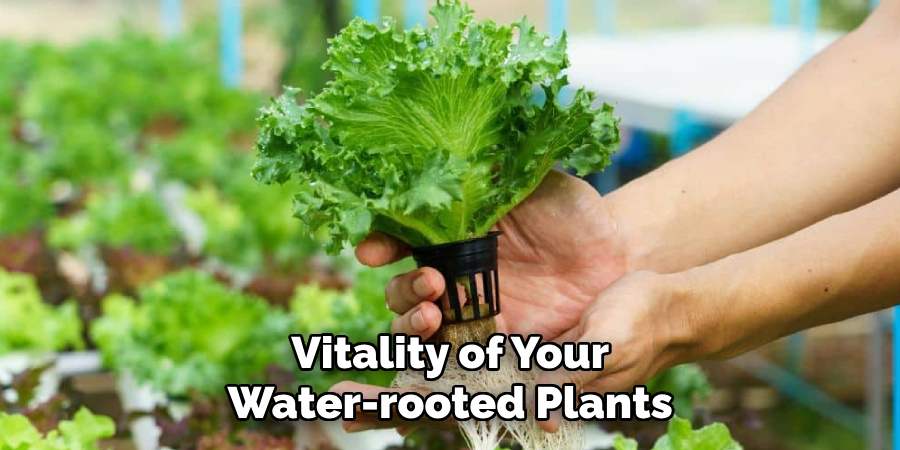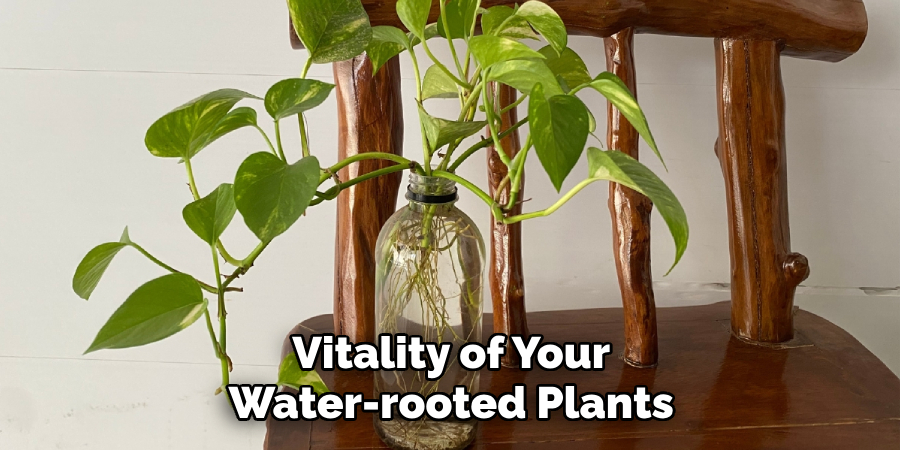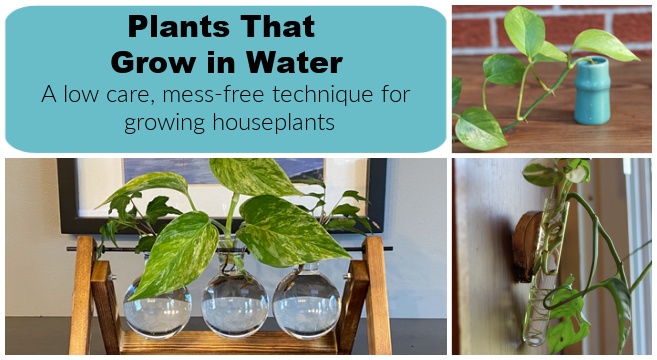To care for houseplants growing in water, keep them in a bright location, change the water regularly, and prune as needed. Houseplants growing in water require proper care to thrive.
A bright location is crucial for their growth and should be chosen, while the water should be changed regularly. Pruning is also necessary to maintain the health and appearance of the plants. By following these simple steps, you can ensure the well-being of your houseplants growing in water.

Credit: savvygardening.com
Can Houseplants Thrive In Water?
Houseplants growing in water? It may sound unconventional, but it is indeed possible. Benefits? Well, they are easy to maintain, requiring minimal effort and time. Plus, they can enhance the aesthetic appeal of any space, adding a touch of greenery.
Furthermore, growing plants in water eliminates the need for soil, reducing the risk of pests and diseases. The process involves placing plant cuttings or root divisions in a jar or vase filled with water, ensuring the roots are submerged. As the plant absorbs nutrients from the water, it flourishes and grows, fulfilling its natural cycle.
So, if you’re looking for a low-maintenance and visually pleasing option, consider growing houseplants in water. Now, let’s explore this concept further and unravel the wonders of hydroponic gardening.
How to Care for Houseplants Growing in Water: Step by Step Guide
Choosing The Right Houseplants For Water Cultivation
Choosing the right houseplants for water cultivation requires considering several essential factors. First, assess the plant’s ability to thrive in water, as not all houseplants are suitable for this growing method. Second, consider the size of the houseplant and ensure it can fit comfortably in the water container.
Third, examine the root systems of the houseplants and select those with roots that can adapt well to water cultivation. Additionally, take into account the lighting requirements of the houseplants and ensure they can receive enough natural or artificial light.
Finally, research popular houseplants that are known to thrive in water, such as pothos, lucky bamboo, and spider plants. By considering these factors and choosing the right houseplants, you can successfully care for your houseplants growing in water.
Getting Started With Water Propagation
Getting started with water propagation is an excellent way to care for houseplants growing in water. Start by selecting healthy cuttings to ensure successful propagation. Next, prepare a water container that is suitable for the cuttings. Place the cuttings in the water, making sure they are fully submerged.
Provide the right conditions for root growth, such as ample sunlight and a warm temperature. Monitor the progress of your cuttings regularly and take proper care of them during the propagation process. By following these steps, you can easily propagate your houseplants in water and enjoy their growth and beauty.
Providing Optimal Environmental Conditions
Houseplants growing in water require optimal environmental conditions for their well-being. Adequate lighting is essential for their growth. The temperature should be suitable, not too cold or hot. Maintaining the right humidity levels is crucial for their survival. Adequate air circulation is necessary for their overall health.
Following these essential guidelines will ensure the proper care of houseplants growing in water.
Choosing The Right Water
Choosing the right water is crucial for the health of houseplants growing in water. Water quality plays a significant role in their overall well-being. There are various types of water suitable for water cultivation, including tap water, filtered water, and rainwater.
Tap water is commonly used, but it can contain impurities that may affect plant growth. Filtered water is a better option as it removes harmful substances. Rainwater is also beneficial as it is natural and free from chemicals. Consider the water source and its quality to ensure the best conditions for your water-grown houseplants.
Proper Watering Techniques
Proper watering techniques are crucial for caring for houseplants growing in water. Changing the water frequently is essential for their well-being. By doing so, you prevent the accumulation of impurities and maintain optimal conditions. Overwatering can be detrimental to the plants, so it is important to be aware of the signs.
If you notice yellowing leaves, root rot, or a foul odor, you may be overwatering. Another issue that can arise with water-based plants is the growth of algae. To combat this, keep the plants in a well-lit area but away from direct sunlight, as excessive light can promote algae growth.
Regularly cleaning the container and adding a few drops of hydrogen peroxide can also help control algae. Overall, following these guidelines will ensure the health and vitality of houseplants growing in water.
Supplementing Nutrients
Supplementing nutrients is crucial for houseplants growing in water, as they rely solely on what we provide. Understanding the nutrient needs of these plants is essential to ensure their health and vitality. When it comes to choosing suitable fertilizers, both organic options and hydroponic fertilizers can be used.

Organic fertilizers, derived from natural sources, are a popular choice for those looking for a more natural approach. These fertilizers release nutrients slowly, providing a steady supply for the plants. On the other hand, hydroponic fertilizers are specifically formulated for plants growing in water and usually contain a balanced mix of essential nutrients.
By selecting the right fertilizer, houseplants growing in water can thrive and display lush foliage. Find out more about caring for these unique plants and the best methods to supplement their nutrient requirements.
Troubleshooting Common Problems
Yellowing leaves are a common issue with houseplants growing in water. This is often due to overwatering or lack of nutrients. To solve this problem, adjust your watering schedule and add a balanced fertilizer. Root rot can also occur, resulting in wilting and decay.
To prevent this, make sure the roots have access to oxygen by changing the water regularly. If pests and diseases are a concern, try using natural remedies such as neem oil or soapy water to control them. Regularly inspect your plants for any signs of infestation and take immediate action.
With proper care and attention, your houseplants can thrive in water without these common problems.
Repotting And Transitioning To Soil
Repotting water-cultivated houseplants into soil requires a proper understanding of the process. Begin by selecting the right time and technique for this transition. Carefully transfer the plant from water to soil, ensuring the roots are well-covered. Avoid common mistakes like disturbing the root system.
Choose a suitable pot and soil mixture to provide adequate nutrients and drainage. Gently pat the soil around the plant to secure it in place. Water the newly potted plant sparingly, allowing the roots to establish in their new environment.
Regularly monitor the plant’s growth and adjust the care routine as needed. By following these steps, you can successfully transition your water-cultivated houseplants into soil.
Frequently Asked Questions For How To Care For Houseplants Growing In Water
How Often Should I Change The Water For My Houseplants?
It is recommended to change the water for your houseplants every 2-4 weeks to prevent the growth of algae and to provide fresh nutrients for your plants. Be sure to rinse the roots and use lukewarm water to avoid shocking the plants.
Can I Use Tap Water For My Houseplants Growing In Water?
Tap water can be used for houseplants growing in water, but it is important to let it sit for 24 hours to allow chlorine to evaporate. If your tap water has a high mineral content, it is best to use filtered or distilled water to avoid mineral buildup on the roots.
How Do I Know If My Houseplants Are Getting Enough Nutrients When Growing In Water?
If the leaves of your houseplants start turning yellow or showing signs of nutrient deficiencies, it means they are not getting enough nutrients. You can add a diluted liquid fertilizer specifically formulated for hydroponic plants to provide the necessary nutrients for healthy growth.
It is important to follow the instructions on the fertilizer bottle for proper dosage.
Conclusion
Caring for houseplants growing in water can be a rewarding and low-maintenance way to bring nature indoors. By following a few simple steps, you can ensure the health and vitality of your water-rooted plants. Regularly change the water to prevent stagnation and keep the roots well oxygenated.

Use filtered or distilled water to avoid any harmful chemicals or minerals. Remember to provide adequate sunlight, as most houseplants still require light to thrive. Keep an eye out for pests or signs of disease, and take prompt action to prevent any further damage.
Overall, growing houseplants in water is a unique and enjoyable way to nurture greenery in your home. With proper care and attention, your water-based plants can flourish and bring beauty to any space.

